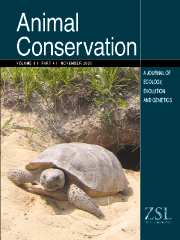Crossref Citations
This article has been cited by the following publications. This list is generated based on data provided by
Crossref.
Amato, George
Egan, Mary G.
and
Rabinowitz, Alan
1999.
A new species of muntjac, Muntiacus putaoensis (Artiodactyla: Cervidae) from northern Myanmar.
Animal Conservation,
Vol. 2,
Issue. 1,
p.
1.
Rabinowitz, A.
Myint, Than
Khaing, Saw Tun
and
Rabinowitz, S.
1999.
Description of the leaf deer (Muntiacus putaoensis), a new species of muntjac from northern Myanmar.
Journal of Zoology,
Vol. 249,
Issue. 4,
p.
427.
Wang, Wen
and
Lan, Hong
2000.
Rapid and Parallel Chromosomal Number Reductions in Muntjac Deer Inferred from Mitochondrial DNA Phylogeny.
Molecular Biology and Evolution,
Vol. 17,
Issue. 9,
p.
1326.
Timm, Robert M.
and
Brandt, John H.
2001.
Pseudonovibos spiralis (Artiodactyla: Bovidae): new information on this enigmatic South‐east Asian ox.
Journal of Zoology,
Vol. 253,
Issue. 2,
p.
157.
Kuznetsov, German V
Kulikov, Eugene E
Petrov, Nikolai B
Ivanova, Natalia V
Lomov, Alexei A
Kholodova, Marina V
and
Poltaraus, Andrey B
2002.
Mitochondrial 12S rDNA Sequence Relationships Suggest That the Enigmatic Bovid “Linh Duong” Pseudonovibos spiralis Is Closely Related to Buffalo.
Molecular Phylogenetics and Evolution,
Vol. 23,
Issue. 1,
p.
91.
DUCKWORTH, J. W.
and
PINE, RONALD H.
2003.
English names for a world list of mammals, exemplified by species of Indochina.
Mammal Review,
Vol. 33,
Issue. 2,
p.
151.
Pitra, Christian
Fickel, Joerns
Meijaard, Erik
and
Groves, Colin
2004.
Evolution and phylogeny of old world deer.
Molecular Phylogenetics and Evolution,
Vol. 33,
Issue. 3,
p.
880.
Dalebout, M. L.
Baker, C. S.
Mead, J. G.
Cockcroft, V. G.
and
Yamada, T. K.
2004.
A Comprehensive and Validated Molecular Taxonomy of Beaked Whales, Family Ziphiidae.
Journal of Heredity,
Vol. 95,
Issue. 6,
p.
459.
May, R. M.
McLean, A. R.
Pattison, J.
Weiss, R. A.
Bell, Diana
Roberton, Scott
and
Hunter, Paul R.
2004.
Animal origins of SARS coronavirus: possible links with the international trade in small carnivores.
Philosophical Transactions of the Royal Society of London. Series B: Biological Sciences,
Vol. 359,
Issue. 1447,
p.
1107.
Sarkar, Sahotra
2005.
Biodiversity and Environmental Philosophy.
Price, Samantha A.
Bininda‐Emonds, Olaf R. P.
and
Gittleman, John L.
2005.
A complete phylogeny of the whales, dolphins and even‐toed hoofed mammals (Cetartiodactyla).
Biological Reviews,
Vol. 80,
Issue. 3,
p.
445.
Meijaard, Erik
and
Groves, Colin Peter
2006.
Primate Biogeography.
p.
305.
Zhou, Qi
Huang, Ling
Zhang, Jianguo
Zhao, Xiangyi
Zhang, Qingpeng
Song, Fei
Chi, Jianxiang
Yang, Fengtang
and
Wang, Wen
2006.
Comparative genomic analysis links karyotypic evolution with genomic evolution in the Indian Muntjac (Muntiacus muntjak vaginalis).
Chromosoma,
Vol. 115,
Issue. 6,
p.
427.
Huang, L.
Wang, J.
Nie, W.
Su, W.
and
Yang, F.
2006.
Tandem chromosome fusions in karyotypic evolution of Muntiacus: evidence from M. feae and M. gongshanensis.
Chromosome Research,
Vol. 14,
Issue. 6,
p.
637.
James, Jiffy
Ramakrishnan, Uma
and
Datta, Aparajita
2008.
Molecular evidence for the occurrence of the leaf deer Muntiacus putaoensis in Arunachal Pradesh, north-east India.
Conservation Genetics,
Vol. 9,
Issue. 4,
p.
927.
BAKER, C. SCOTT
2008.
A truer measure of the market: the molecular ecology of fisheries and wildlife trade.
Molecular Ecology,
Vol. 17,
Issue. 18,
p.
3985.
Han, Sang-Hyun
Lee, Sung-Soo
Cho, In-Cheol
Oh, Moon-You
and
Oh, Hong-Shik
2009.
Species Identification and Sex Determination of Korean Water Deer (Hydropotes inermis argyropus) by Duplex PCR.
Journal of Applied Animal Research,
Vol. 35,
Issue. 1,
p.
61.
Le, Minh
Nguyen, Thanh V.
Duong, Ha T.
Nguyen, Ha M.
Dinh, Long D.
Do, Tuoc
Nguyen, Hai D.
and
Amato, George
2014.
Discovery of the Roosevelt’s Barking Deer (Muntiacus rooseveltorum) in Vietnam.
Conservation Genetics,
Vol. 15,
Issue. 4,
p.
993.
Kasperski, Andrzej
and
Kasperska, Renata
2016.
A new approach to the automatic identification of organism evolution using neural networks.
Biosystems,
Vol. 142-143,
Issue. ,
p.
32.
Adler, Peter H.
Takaoka, Hiroyuki
Sofian-Azirun, Mohd
Low, Van Lun
Ya’cob, Zubaidah
Chen, Chee Dhang
Lau, Koon Weng
Pham, Xuan Da
and
Castiglia, Riccardo
2016.
Vietnam, a Hotspot for Chromosomal Diversity and Cryptic Species in Black Flies (Diptera: Simuliidae).
PLOS ONE,
Vol. 11,
Issue. 10,
p.
e0163881.


